There are many reasons to be excited about the 1888 Penny; chief among them is that the coin is a key date in the Indian Head series of cents. But what is the value of the 1888 Indian Head Penny?
The short answer is between $1.50 and $12,000. In some cases, these coins can even sell for more; it all depends on the condition of the coin and how it was struck. In this guide, we’ll be debunking not only the value of the 1888 Indian Head Penny in various conditions but also its history and some of the error coins it spawned.
Coin Valuation Chart
| Coin Condition | Estimated Value | |
| 1888 Indian Head Penny | 1888 Proof Indian Head Penny | |
| Heavily Circulated
(FR2 – XF40) |
$1.05 – $25 | – |
| About Uncirculated (AU50 – AU58+) | $35 – $60 | – |
| Uncirculated
(MS60 – MS64+) |
$75 – $1,000 | $200 – $1.300 |
| Brilliant Uncirculated (MS65 or higher) | $500 – $12,000 | $425 – $12,000 |
But before we start unraveling the enigma that is the 1888 Indian Head Penny, why don’t we get familiar with this vintage coin?
Know Your Penny: Features of the 1888 Indian Head Penny
- Mass: 3.11 grams
- Diameter: 19.00 mm

From its name alone, we can derive two superficial features of the 1888 Indian Head Penny: the date “1888” and the central depiction on the obverse, “The Indian Head.” Contrary to popular belief, this depiction is not of a Native American but rather that of Lady Liberty. And that’s why “LIBERTY” is inscribed along the strap that holds the feathers.
This design of Lady Liberty wearing a Native American warbonnet was imagined by James Barton Longacre, the fourth Chief Engraver of the U.S. Mint and designer of the Three-Cent Pieces and the Double Eagle. Longacre marked his contribution to the Indian Cents by incorporating the initial “L” along one of the ribbons that tie Ms. Liberty’s warbonnet.
Longacre complements his “Indian Head” with an engulfing inscription of the country of issue: “UNITED STATES OF AMERICA.” Directly below Lady Liberty’s bust is the date “1888,” which bends with the penny’s curvature.
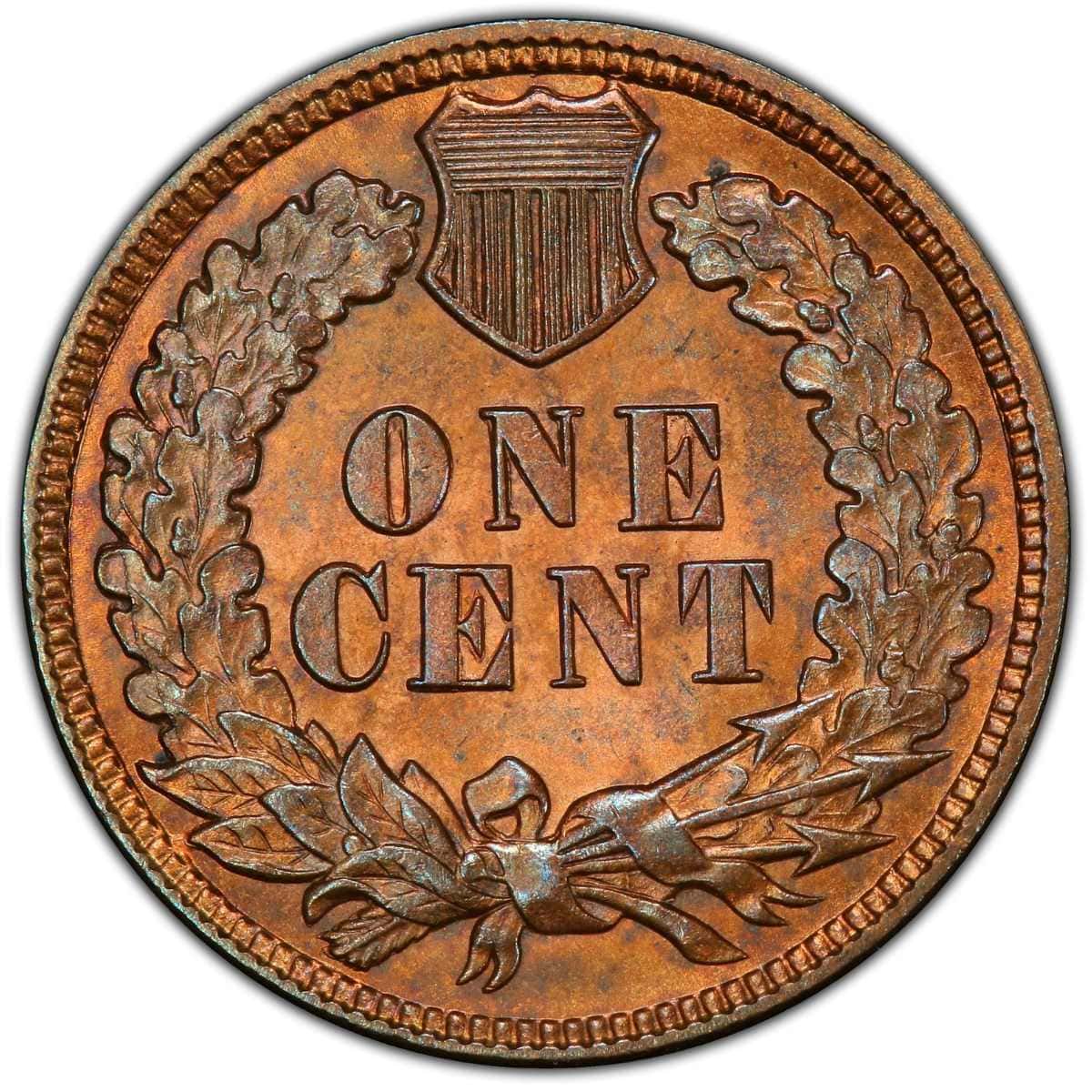
The reverse of the 1888 Penny was also designed and executed by Longacre. The most prominent element on this face must be the denomination “ONE CENT,” which is placed at the coin’s center. Directly above the denomination is the “Union Shield” with horizontal and vertical stripes. He also includes a mixed-material wreath tied together with a ribbon and three pointy arrows.
And while the coin’s edge is as plain as modern pennies, the rims on either side of the 1888 Indian Head Penny are ornamented with fine denticles.
Coin Anatomy
- Copper: 95%
- Tin & Zinc: 5%
The 1888 Indian Head Penny was minted years after the implementation of the Coinage Act of 1864. This Act of Congress ushered the U.S. Penny into the bronze era, meaning all pennies post-1864 were made from bronze alloys. The U.S. Mint sought inspiration from French Bronze, a blend of 95% copper and a 5% mixture of zinc and tin.
These metals are blended to yield bronze planchets rich in red pigmentation. But as the coins aged, some of them lost their original red luster in favor of a brown color. Thanks to this behavior of bronze metals, the color spectrum of the 1888 Penny offers three color varieties: Red, Red-Brown, and Brown. We discuss this concept in detail in our coin color guide, which we invite you to check out.
Historical Background of the 1888 Indian Head Penny
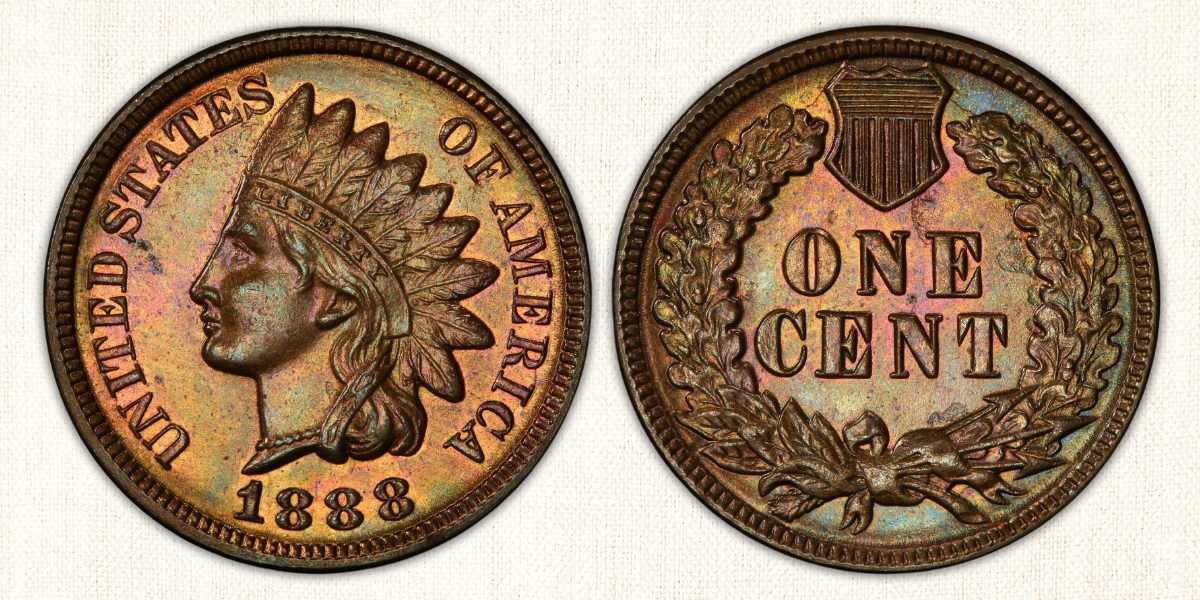
In 1888, pennies were exclusively minted at the Philadelphia Mint, which didn’t use a mint mark, so the 1888 Indian Head Penny lacks any such mark. The facility made both business and proof strikes of the 1888 Penny.
However, what was noteworthy about pennies of this era was not the nature of the strikes but rather the techniques that the U.S. Mint employed in striking these coins. In the 1880s, the U.S. Mint forged dateless dies that struck coins without dates. The idea was that the date could be punched later on; plus, it gave the U.S. Mint a lot of flexibility on what dates they could strike on these coins.
This technique of striking dates separately led to issues like misplaced dates (MPDs), repunched dates, and overdate errors. However, the misfortunes of the U.S. Mint turned out to be an opportunity for savvy coin collectors. Over the 135 years since these coins were released, coins with these deficiencies have been highly sought after and for handsome prices, and this is why we feature these inadequacies in the error section.
But before we get to those, why don’t we discuss the values of the 1888 Penny varieties you’re most likely to encounter?
1888 Indian Head Penny Value, Population, and Notable Auctions
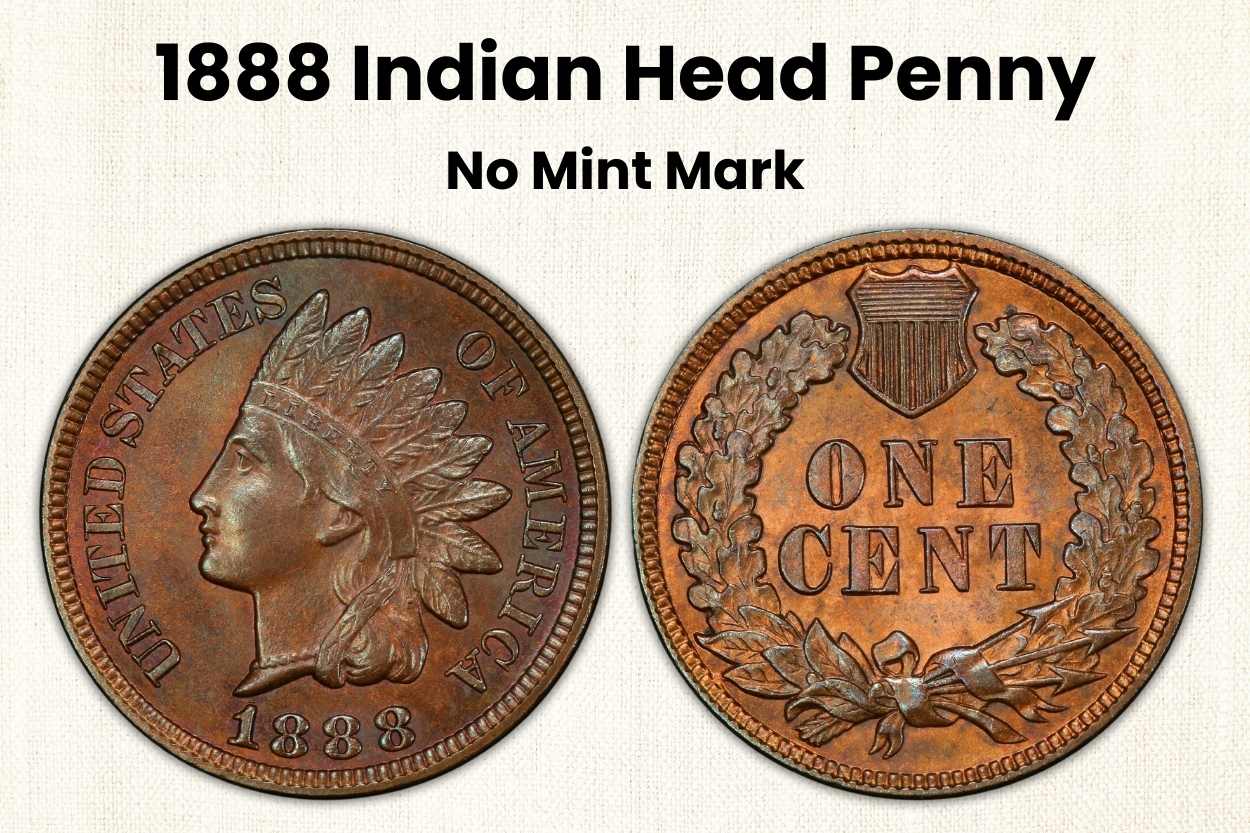
- U.S. Mint Branch: Philadelphia
- Mintage: 37,489,832
- Mint Mark: None
The business strike of the 1888 Indian Head Penny is worth anything from $1.50 to $12,000, depending on the cent’s condition. As the business strike, this variety enjoyed its time in circulation until the 1930s when coin collectors started pulling them for preservation.
Today, the 1888 Indian Head Penny is quite common in all grades until MS66. In circulated conditions, an 1888 Indian Penny will have lost most, if not all, of its original red pigmentation. They will be designated as Brown with values that range from $1.50 to $60.
In mint condition, these pennies are available in Brown, Red- Brown, and Red colors. An 1888 Indian Head Penny will gain value the more of its initial red luster it retains. Brown 1888 Indian Cents are worth between $75 and $500 in mint condition. They will be relatively common.
Thinner in numbers are Red-Brown 1888 Indian Head Pennies. These cents are almost always in uncirculated conditions with values that range from $125 to $1,850.
However, the most sought-after pennies in this variety are the Red 1888 Indian Cents. They are the most rare in the variety and the most valuable. They are attainable between MS63 and MS66, albeit with high price tags. Between these conditions, these Indian Head Pennies can be had from $400 to $12,000.
| Coin Condition | Estimated Value | ||
| Brown (BN) | Red-Brown (RB) | Red (RD) | |
| Poor (PO1) | $1.50 | – | – |
| Good (G4) | $2 | – | – |
| Very Good (VG8) | $3 | – | – |
| Fine (F12) | $5 | – | – |
| Very Fine (VF20) | $10 | – | – |
| Extremely Fine (XF40) | $25 | – | – |
| About Uncirculated (AU50) | $35 | – | – |
| About Uncirculated (AU58) | $60 | – | – |
| Uncirculated (MS60) | $75 | – | – |
| Uncirculated (MS61) | $90 | $125 | – |
| Uncirculated (MS63) | $140 | $200 | $400 |
| Brilliant Uncirculated (MS65) | $500 | $1,100 | $2,250 |
| Brilliant Uncirculated (MS66) | – | $1,850 | $12,000 |
There are quite a few 1888 Indian Head Pennies that have popped up in MS67RD condition. The most valuable was sold in 2008 for $63,250. The penny was graded by the Professional Coin Grading Service (PCGS), who bestowed MS67RD on the coin, making it one of two 1888 Pennies granted that status by the reputable grading service. PCGS has yet to encounter finer pennies.
The most recent sale of a similarly-graded penny was completed in February 2021, and that 1888 Penny sold for $23,400.
1888 Proof Indian Head Penny Value, Population, and Notable Auctions
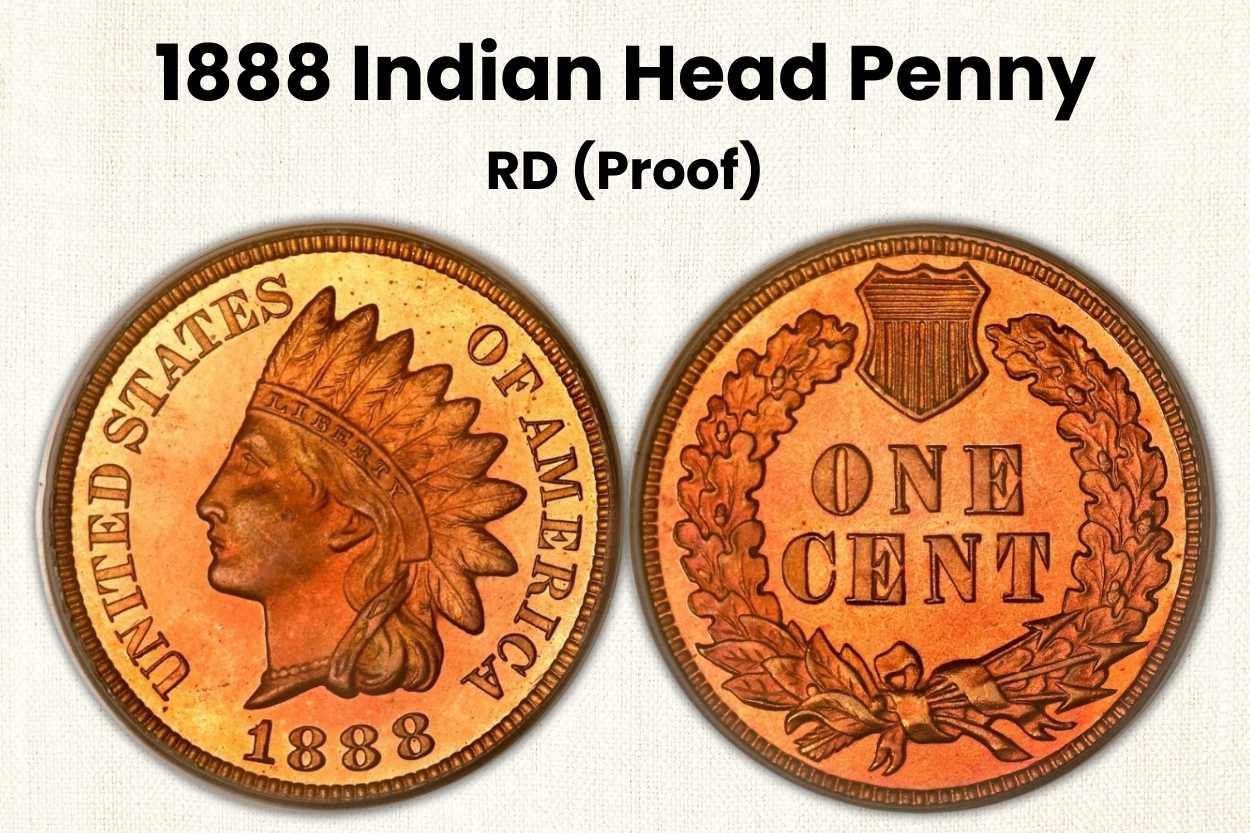
- U.S. Mint Branch: Philadelphia
- Mintage: 4,582
- Mint Mark: None
Proof 1888 Indian Head Pennies are worth between $200 and $12,000. These pennies skipped circulation, so they will always be in mint condition. However, most of them will have lost all, if not most, of their cameo contrast.
While they remain proof strikes, these cents are classified like business 1888 Indian Pennies with Brown, Red, and Red-Brown designations. The value of a specific cent is dependent on the color and condition of the penny.
Brown 1888 Proof Indian Cents are the most abundant in this variety, with values that start at $200 for MS60 examples and soar to $2,900 for MS67 gems.
Red-Brown 1888 Indian Head Pennies offer more value despite being less abundant than their Brown counterparts. They are worth between $260 and $3,000.
As you would expect, Red 1888 Indian Head Pennies pack the most value. They are quite rare and won’t come cheap. They are worth anywhere between $450 and $12,000.
| Coin Condition | Estimated Value | ||
| Brown (BN) | Red-Brown (RB) | Red (RD) | |
| Uncirculated (PR61) | – | – | – |
| Uncirculated (PR62) | $200 | $260 | – |
| Uncirculated (PR63) | $225 | $300 | $450 |
| Uncirculated (PR64) | $300 | $450 | $1,300 |
| Uncirculated (PR65) | $425 | $675 | $4,500 |
| Uncirculated (PR66) | $1,200 | $3,000 | $12,000 |
| Uncirculated (PR67) | $2,900 | – | – |
| Uncirculated (PR68) | – | – | – |
However, a few 1888 Proof Pennies have sold for more money. The most notable is the 2014 auction of an 1888 Proof Indian Head Penny for $15,000. The penny is one of two Indian Cents graded PR66RD by PCGS. No other 1888 Penny is finer.

1888 Indian Head Penny: Common Error Coins
The U.S. Mint’s use of dateless dies invited a slew of different issues ranging from repunched dates (RPD), misplaced dates (MPD), and overdate errors. But how valuable are the 1888 Indian Head Pennies afflicted with these errors?
Repunched Dates (RPD), FS-302
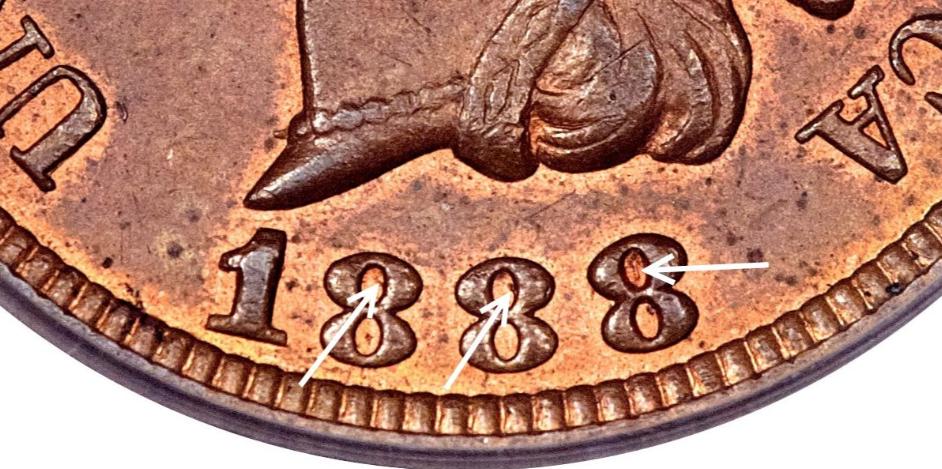
The use of dateless dies allowed mint workers to punch dates later on in the minting process. However, it wasn’t uncommon for these artisans to punch weak dates on the first round. Under these circumstances, having another go was a natural remedy for the initial error. An 1888 Indian Head Penny that needed more than one punch to engrave its date is said to have a Repunched Date.
This error only affected the business strikes of the 1888 Indian Cents. The affected coins will be showing blobs and traces of the first date punch on the fields inside the 8s of the date. The “1” may also show some doubling around its edges.
1888 Indian Head Pennies, RPD, are available in all grades, albeit in minimal numbers. Their scarcity and collectors’ interest in them have made them valuable coins. In circulated conditions, an 1888 Indian Head Penny, MFD, is worth between a modest $38 and a hefty $635. In mint condition, they are available up to MS64+ with value estimates that range between $700 and $1,300.
| Coin Condition | Estimated Value | ||
| Brown (BN) | Red-Brown (RB) | Red (RD) | |
| Heavily Circulated
(AG3 – XF45+) |
$38 – $535 | – | – |
| About Uncirculated (AU50 – AU58+) | $550 – $635 | – | – |
| Uncirculated
(MS60 – MS64+) |
$700 – $1,300 | $850 – $2,750 | – |
| Brilliant Uncirculated (MS65 or higher) | – | – | – |
Misplaced Dates (MPDs), FS-303, FS-304, and FS-305

Another date-related issue the U.S. Mint failed to overcome was the Misplaced dates. Mint workers weren’t consistent with where they punched their dates; some veered off to the left while others went to the right. From the coins we’ve studied, there are three varieties of Misplaced Dates, namely, FS-303, FS-304, and FS-305.
In circulated conditions, 1888 Indian Head Pennies, MFD, are valued between $10 and $265. In mint conditions, gems are available only until MS64+. Their estimated values range from $175 to $800.
| Coin Condition | Estimated Value | ||
| FS-303 | FS-304 | FS-305 | |
| Heavily Circulated
(AG3 – XF45+) |
$44 – $175 | $35 – $102 | $10 – $105 |
| About Uncirculated (AU50 – AU58+) | $200 – $265 | $162 – $215 | $125 – $145 |
| Uncirculated
(MS60 – MS64+) |
$310 – $400 | $300 – $800 | $175 – $650 |
| Brilliant Uncirculated (MS65 or higher) | – | – | – |
1888/7 Overdate Error
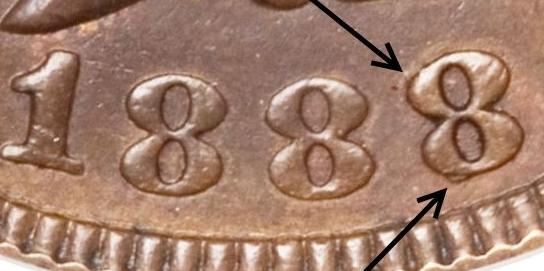
The final date-themed error is the 18887 Overdate Error, which is sometimes designated as FS-301 or just 1888/7 (1888 over 7). This mint error arose from the Philadelphia Mint’s attempt to rebrand 1887 Pennies as 1888 Indian Cents. They struck an “8” over the “7” of the 1887 date.
1888/7 Indian Head Pennies will be showing traces of “7” under the final “8” of the 1888 date.
The 1888/7 Indian Head Penny is by far the most sought-after variety in the 1888 Indian Cent family, making it valuable in any condition. In circulated states, they can fetch between $1,100 and $34,000. In mint condition, their values soar to $75,000, and they can sell for up to $90,000.
| Coin Condition | Estimated Value | ||
| Brown (BN) | Red-Brown (RB) | Red (RD) | |
| Heavily Circulated
(AG3 – XF45+) |
$1,100 – $12,250 | – | – |
| About Uncirculated (AU50 – AU58+) | $16,000 – $34,000 | – | – |
| Uncirculated
(MS60 – MS64+) |
$75,000 | $80,000 – $90,000 | – |
| Brilliant Uncirculated (MS65 or higher) | – | – | – |
Final Thoughts
What makes the 1888 Indian Head Penny a key date and an attraction to collectors is neither the business strikes of the penny nor the proof variety of the cent. The 1888 Indian Cent is attractive because of the date-themed errors it accrued during its time in production.
If you’re lucky enough to cross paths with an 1888 Penny, study its dates and check for irregularities. You could be holding an exceptional Indian Head Penny.
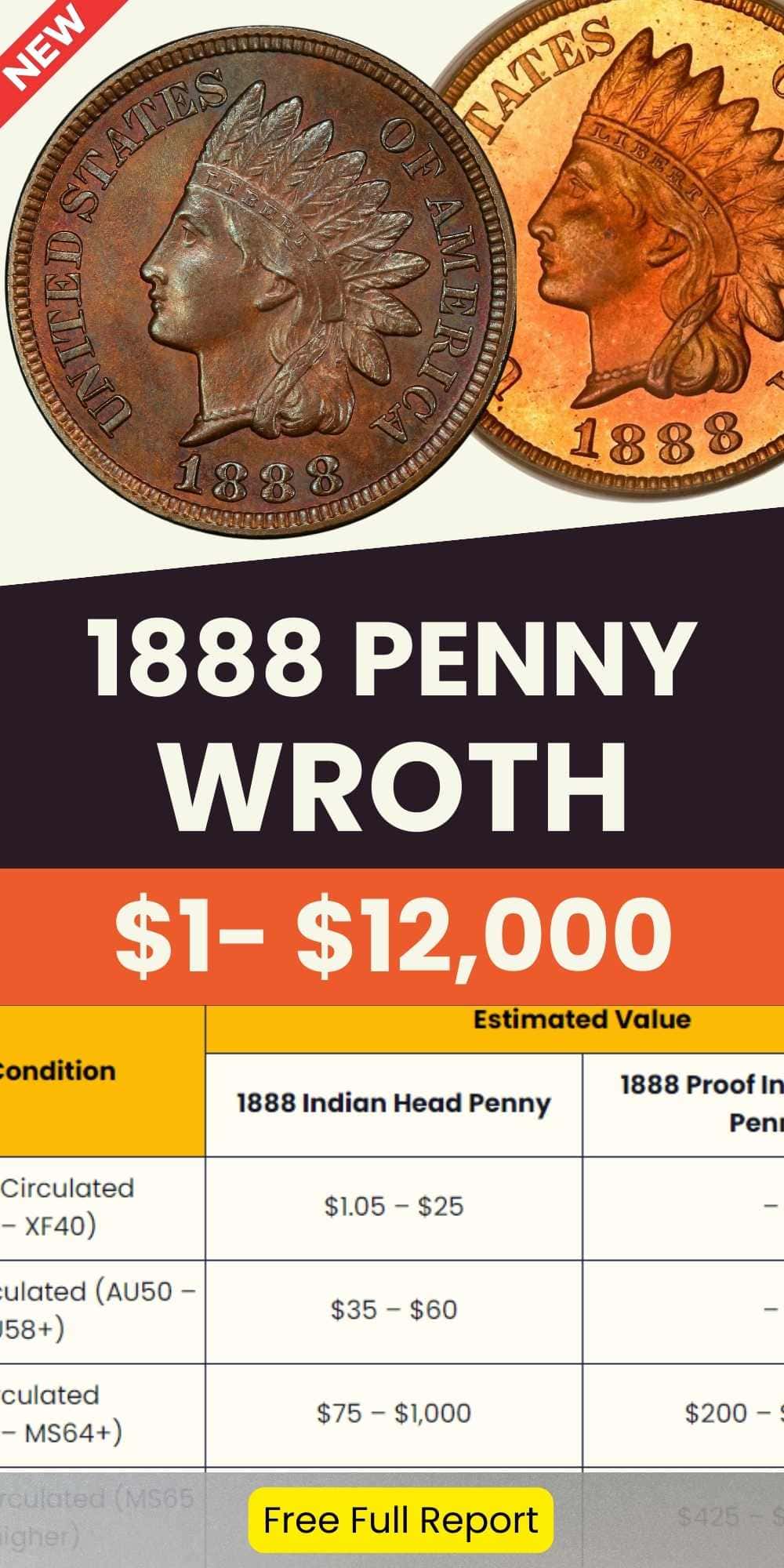

Jenson is a professional numismatist, a dedicated coin collector, a graduate of the College of Business at Oregon State, a life member of the American Numismatic Association (ANA), and an overall coin nerd. He is the founder of Coin Value List.
